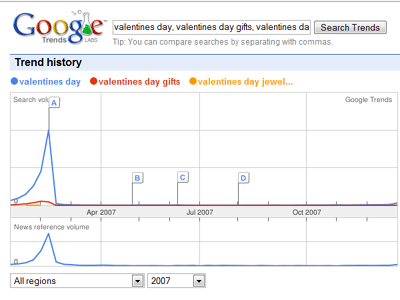How to Predict When Your Traffic Will Drop and Ways to Prevent It

 |
As part 2 of our ‘Walk a Mile in a Searcher’s Shoes’ Series, today is mile 2! Now that the major holidays are over, I look back at what I could have done differently to maximize traffic and revenue for my clients through PPC. It’s actually very obvious, if I were to have just looked at the past year performance of my PPC account, I would have known which keywords increased in conversions or dropped in traffic during the holidays. With this information I could have taken several steps to prevent a decline in traffic or potentially generate more revenue from my e-commerce sites.
In this post I’ll discuss ways on how to be proactive when it comes to paid search techniques. I’ll also talk about the different tools you can use to predict when there may be a traffic increase or decrease.
PPC traffic can have many ups and downs throughout the year. Christmas and Cyber Monday are typically peak times for e-commerce sites. But what about times when search traffic increases or decreases during times other than major holidays? Do you know when to expect a surge or drop in traffic? Do you know how to accentuate the traffic surges, and mitigate the decreases? Or do you wait until it happens, then react?
Why is it important to predict traffic patterns before they actually happen you ask? A pattern that a lot of people get stuck in is being reactionary rather than proactive. If you’re just treading along and everything is going well, then one day your traffic suddenly drops, then you go in a reactionary mode to try and fix what went wrong. Being proactive means you know that traffic may decrease and you can do things early on to prevent any major drops in traffic. Being proactive also means you can find things that may cause traffic to increase during a certain time, and you can then position yourself in advance so you’re not late in the game and allow other competitors to get your customers.
Google Trends: Google Trends is a free tool that allows you to enter several keywords at a time, and determine when the peak search times are for those keywords. You can set it up so it shows you peak times throughout the year, month, etc.
Example, if I were to have a client who sold valentines day gifts, and I wanted to know approximately when people begin their search for these items, I can enter a few keywords that relate to valentines day gifts into Google Trends and see approximately when people being their search online for these items. Instead of waiting until a week before Valentines day, I can now position my ads to show a few weeks if not a mo nth early than normal to maximize traffic and conversions for those valentines day related items.

Google Adwords/Yahoo! Reporting: A second area where you can look to find search patterns for your industry are your own Google Adwords, Analytics and Yahoo reports. You can easily run a keyword report for an entire year, month or single day and find out which keywords peak and dip within the time frame specified. With that information you can plan out the year on what keywords you should bid higher on to gain more traffic or to bid less on because people don’t normally convert well during a particular time.
Example: A site that sells pet products such as food and toys for cats, dogs and birds. With a report on the past year performance in Google Adwords you may be able to determine that people buy products for cats more in the spring time, products for dogs more during Christmas, and products for birds more during the summer. In this case, I would focus more on products for dogs during Christmas than I would in the spring or summer. By “focus” I mean bidding higher on better converting keywords; I would try to add additional keywords for products to my list during this time’ and I would talk with my client about featuring dog products on the landing page over cats and birds during this time.
By being proactive and knowing when traffic patterns increase and decrease, you can take the necessary steps to get in front of your customer before your competition does and maximize traffic and revenue!



